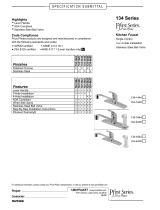11
GUARANTEE AND ASSISTANCE
AEROTECNICA COLTRI S.r.l. guarantees its compressors against any design or manufacturing defect
or fault and against any fault in the materials for a period of twelve months from the delivery of the
machine. The customer must inform AEROTECNICA COLTRI S.r.l. in writing of any fault and/or defect
that may be found within eight days from its discovery by means of a registered letter with advice of
receipt or telegramme, otherwise the guarantee will become null and void.
The guarantee is only valid against faults or defects that may arise with the compressor used under
proper operating conditions according to the instructions given in this manual and with the maintenance
carried out at the intervals as provided for.
The guarantee expressly excludes any faults arising as a result of improper use of the machine, of
atmospheric agents and of damage due to transport; the guarantee does not cover the expendable
materials and materials required for the periodic maintenance which are at the customer’s entire
expense. The guarantee will, in any case, become automatically null and void if the compressor is
tampered with or if it has been serviced by technicians who are not authorized to do so by
AEROTECNICA COLTRI S.r.l.
Any compressor that is acknowledged to be faulty due to defects in the design, manufacturing or materials
used, will be repaired or replaced free of charge by AEROTECNICA COLTRI S.r.l. at its factory in San
Martino della Battaglia (BRESCIA). The customer will be responsible for the costs of transport and
carriage as well as for any spare parts and expendable materials.
If it should be necessary for service to be carried out under the guarantee at the customer’s premises,
the latter will be responsible for the travel and transfer costs for the staff sent out by
AEROTECNICA COLTRI S.r.l.
Taking delivery of the machine and/or of any faulty components or the transfers for the inspection of
faults and/or defects as notified by the customer, will not, however, denote any implicit acknowledgement
regarding the effectiveness of the guarantee.
Repairs and/or replacements made by AEROTECNICA COLTRI S.r.l. during the guarantee period will
not extend the duration of the same.
Acknowledgment of the guarantee does not itself imply any liability for compensation on the part of
AEROTECNICA COLTRI S.r.l.
AEROTECNICA COLTRI S.r.l. does not assume any responsibility for injury to persons or damage to
property or for any other direct or indirect damage (loss of production or missed profit, etc.) that may be
attributable to faults or defects of the compressor, except for those cases in which a serious fault can be
attributed to the company.
Guarantee
Assistance
The AEROTECNICA COLTRI S.r.l. technicians are available for any kind of routine or additional
maintenance work.
The request for technical assistance must be sent to AEROTECNICA COLTRI S.r.l. at the following
address:
AEROTECNICA COLTRI S.r.l.
Via Colli Storici, 177
25010 San Martino della Battaglia (BRESCIA) ITALIA
Fax: +39 030 9910283
Guarantee and assistance
1
1.1
1.2
























